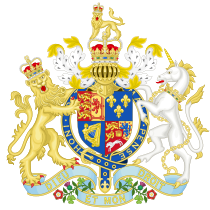The Anatomy Act 1832 (2 & 3 Will. IV c. 75), known popularly as the Dead Body Bill or the Blood-Stained Anatomy Act,[1] is an Act of Parliament of the United Kingdom intended to increase the number of corpses available for dissection by medical students.[1] It was enacted in response to public revulsion at the activities of those such as the body-snatchersThose who exhumed the bodies of the recently deceased during the 18th and 19th centuries to provide cadavers to anatomists for their research. John Bishop and Thomas Williams, known as the London Burkers because they based their crimes on the notorious Burke and Hare murdersSeries of 16 killings committed over a period of about ten months in 1828 in Edinburgh, Scotland. They were undertaken by William Burke and William Hare, who sold the corpses to Robert Knox for dissection at his anatomy lectures. of 1828.[2][a]The London Burkers were active for a few months in London in 1831.
Background
In March 1828 three defendants charged in Liverpool with conspiracy and unlawfully procuring and receiving a corpse buried in Warrington were acquitted, while the remaining two were found guilty of possession. The presiding judge’s comment, that “the disinterment of bodies for dissection was an offence liable to punishment”, prompted parliament to establish the 1828 Select Committee on Anatomy.[3][b]The committee’s administrative records were lost in the 1834 Burning of Parliament and only its minutes and report are extant.[3] The committee took evidence from 40 witnesses: 25 members of the medical profession, 12 public servants and 3 resurrectionists, who remained anonymous.[4] Discussed were the importance of anatomy, the supply of subjects for dissection and the relationship between anatomists and resurrectionists. The committee concluded that dissection was essential to the study of human anatomy and recommended that anatomists be allowed to appropriate the bodies of paupers.[5]
Parliamentary bills
The first bill was presented to parliament in 1829 by Henry Warburton, author of the Select Committee’s report.[6] Following a spirited defence of the poor by peers in the House of Lords, it was withdrawn,[c]The Archbishop of Canterbury, Earls of Malmesbury and Harewood, and the Lord Chief Justice, Lord Tenterden, argued that the poor had a right to a decent burial and questioned if people who had broken no laws should be classed alongside murderers. An “unconquerable objection” to dissection held by many paupers was also mentioned.[7] but almost two years later Warburton introduced a second bill, shortly after the execution of the London Burkers.[2] The resulting wave of social anxiety helped speed Warburton’s bill through parliament,[8] and with little parliamentary opposition the Anatomy Act became law on 1 August 1832.[9]
The Act abolished that part of the Murder Act 1752Act of parliament of England and Wales to increase the horror of being executed for murder by expediting the process and denying the right to a decent burial. allowing murderers to be dissected, ending the centuries-old tradition of anatomising felons, although it neither discouraged nor prohibited body snatching, or the sale of corpses, whose legal status remained uncertain.[d]The Act left Burking, the crime that had helped push Warburton’s bill through parliament, still feasible. It also allowed a person’s body to be given up for “anatomical examination”, provided that the person concerned had not objected. As the poor were often barely literate and therefore unable to leave written directions in the event of their death, it meant that masters of charitable institutions such as workhouses
Establishment where the destitute in England and Wales received board and lodging in return for work. had the power to decide who went to the anatomist’s table. A stipulation that witnesses could intervene was also open to abuse, as such witnesses might be fellow inmates who were powerless to object, or workhouse staff who stood to gain financially.[10]
Legacy
The Anatomy Act 1832 was ineffective in its aim to increase the number of cadavers available for anatomical dissection: 600 were available to medical schools in 1832–1833, but that number had fallen to 430 by 1845–1846.[1]
Neither did the Act quell the public’s concern about dissection. In 1832 there were a growing number of protests, one of the most serious in Manchester. During a cholera epidemic in September 1832 a three-year-old boy was discovered by his grandfather to have been buried with a brick replacing the boy’s missing head, after his death at the Swan Street Cholera Hospital in the city.[1]
The Anatomy Act 1984 (Commencement) Order 1988 mandated that anyone licensed to practise anatomy under the 1832 Act would lose that right on reaching the age of seventy, and that those premises licensed under the 1832 Act should apply for a new licence.[11]
The Human Tissue Act 2004 now lays out the legal framework for the “removal, storage, use and disposal of human bodies, organs and tissue” in England, Wales and Northern Ireland.[12] Similar legislation was passed by the Scottish devolved government with the Human Tissue (Scotland) Act 2006.[13]
Notes
| a | The London Burkers were active for a few months in London in 1831. |
|---|---|
| b | The committee’s administrative records were lost in the 1834 Burning of Parliament and only its minutes and report are extant.[3] |
| c | The Archbishop of Canterbury, Earls of Malmesbury and Harewood, and the Lord Chief Justice, Lord Tenterden, argued that the poor had a right to a decent burial and questioned if people who had broken no laws should be classed alongside murderers. An “unconquerable objection” to dissection held by many paupers was also mentioned.[7] |
| d | The Act left Burking, the crime that had helped push Warburton’s bill through parliament, still feasible. |


